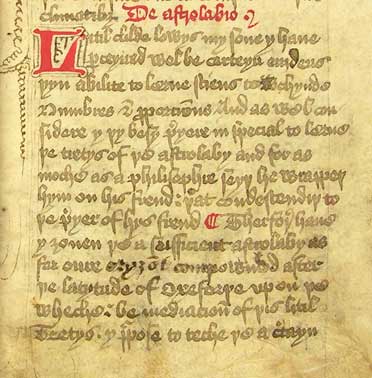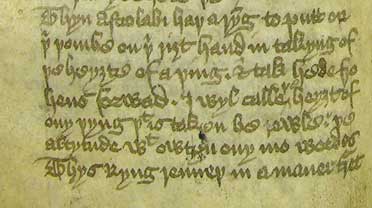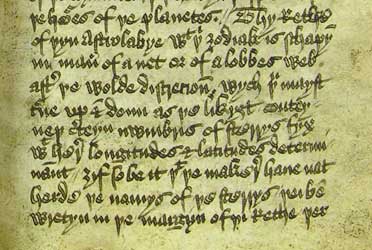Geoffrey Chaucer's Treatise on the Astrolabe
Geoffrey Chaucer (c. 1340 to 1400) is most famous for having written The Canterbury tales. His Treatise on the astrolabe was written during the 1390s. It is the first 'technical manual' of its kind to be written in English instead of Latin, Greek, or Arabic. It was evidently a popular work because it exists today in more manuscript copies that any other of Chaucer's works except the Tales.
Chaucer's text is based on several pre-existing works. His two most important sources are De sphaera (Of the spheres) by the mathematician John de Sacrobosco (died c. 1236) and the Compositio et operatio astrolabii (The construction and use of the astrolabe) at one time attributed to Masha' allah, but now thought probably to be the work of more than one author.
Chaucer's treatise is addressed to 'little Lewis', a ten-year-old child who may or may not have been Chaucer's own son. The first part of the treatise first describes all the parts of an astrolabe and how they fit together. Then, in more than forty 'conclusiouns' or propositions, he explains how to use the astrolabe to ascertain dates and times, and to measure the position of various celestial bodies in the sky in relation to the earth and to each other.
The manuscript was produced in England in the very late fourteenth or early fifteenth century and it is believed to be one of the earliest surviving copies of the work. It was given to St John’s College in 1635 by Thomas Wriothesley, Earl of Southampton.
This astrolabe in the Museum of the History of Science in Oxford is English and dates from c. 1370. It has many similarities in shape and form to the astrolabe described by Chaucer. No extant astrolabe has been identified as the exact model owned by Chaucer himself.
|
Little child Lewis, my son, I have perceived well by certain evidence your ability to learn science touching numbers and proportions. And I also consider your request in particular to learn the treatise of the astrolabe. And for as much as a philosopher says "he wraps himself in his friend that condescends to the request of his friend", therefore have I given you an astrolabe sufficient for our location, calibrated to the latitude of Oxford, upon which is the text of this little treatise. |
|
Your astrolabe has a ring to put on your thumb on your right hand when taking the height of anything. And take heed, from henceforward I will call the height of anything that is taken with the rule the altitude, without any more words. |
|
The rete of your astrolabe, with the zodiac, is shaped in the manner of a net or of a spider's web, after the old custom, which you may turn up and down as you like, it contains certain numbers of the fixed stars with their longitudes and latitudes determined, if so be it that the maker has not erred. The names of the stars are written in the margin of the rete. |


